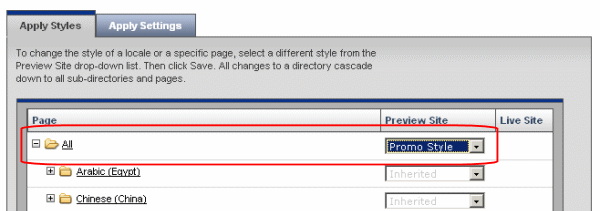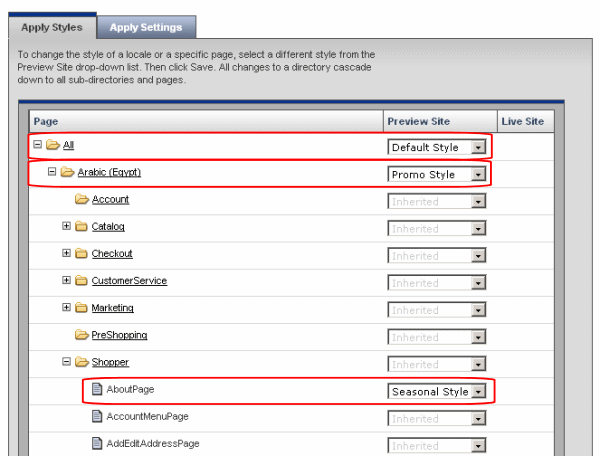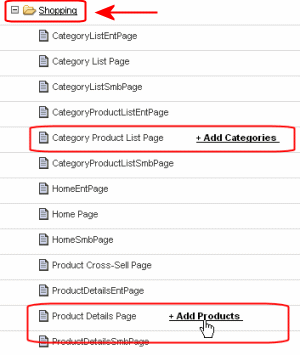A theme is a group of styles that are applied to pages on your site. When you create a theme, you choose the styles that make up the theme, the pages on your site that should use those styles, and the shopping cart options for the theme.
Styles in a theme can be applied to all pages, to groups of pages (such as Shopping Cart pages), or to individual pages (such as the Product Detail page) on your site. If your site supports multiple locales you can apply styles to all or some of the pages in each supported locale and define the shopping cart options by page and locale.
Themes can also be used in combination with Purchase Plans, to provide a unique, branded shopping experience. See About Purchase Plans for more about Purchase Plans.
If you set a specific style for the Category Products List page or Product Detail pages, you can choose the specific categories or products you want to use the style, or have the style used on all those pages. See Step 6 in this topic to apply a style to products or categories.
If you edit a theme that has previously been deployed, the Version list will appear. From this list, select the version of the theme you want to edit and then click the Edit button to unlock the theme and begin making changes.
To create a theme:
- On the Storefront menu, select Store Builder, click Create Theme.
- In the Name field, enter or edit the name for the theme. This is for your use only and is not seen by shoppers on your site.
- If desired, enter or edit the Description for the theme. Descriptions are optional and not seen by shoppers on your site.
- Select the Use as Default
Theme check box if you want the theme you are creating to be used as the default for your site.
If you have not created a theme yet, or you only have one, this check box is grayed out and unavailable. If you have multiple themes, you can select this check box to use the current theme as the default.
Tip: Click Apply as you enter information or make changes to save and continue working on the page.
- On the Apply
Styles tab, in the Preview Site column, select the styles you want to use for the locales, page groups, and pages listed. Click the + to expand the list
of items.
When Inherited appears in the Preview Site list it means that the item (locale, page group, or page) will inherit the style set for the item directly above it in the hierarchy.
The Preview Site list shows the style for the preview site (not yet deployed). The Live Site column lists the style for the live site (the style currently viewable on the site). If the Live Site column is empty it means that no style has been applied to that locale, page group, or page.- To set one style for all pages in all locales,
locate the All folder at the top of the Page column and select the style to use from the Preview
Site list. All pages on your site and in every locale will use this
style unless you set a different style for individual pages or page groups.
- To set styles by locale, page group, and/or individual page, from
the Preview Site list, select
a style for the locale, page group, or individual page. You can set as many different styles for as many locales, page groups, and individual pages as you want.
- To set a style for the Category Product List page and/or the Product Detail pages, for the locale you want to change, open the Shopping folder list. Then, select the style you want from the Preview Site list. To define which categories or product pages use the style, click the Add Categories or Add Products link. On the page that appears, search for and then select the categories or products you want to use the style.
- To set one style for all pages in all locales,
locate the All folder at the top of the Page column and select the style to use from the Preview
Site list. All pages on your site and in every locale will use this
style unless you set a different style for individual pages or page groups.
- On the Apply Settings tab:
- Make sure the Default Settings option is selected for the locale you want to be the default for these settings. The system automatically chooses the default site locale as the default but you can choose another locale if needed.
- Set the default settings: First, select or clear the Display Continue Shopping Button check box to show or hide a Continue Shopping button in the shopping cart. This button takes shoppers back to where they
were when they entered the cart, or you can customize it to go somewhere else,
like your company Web site.
Then, select or clear the Customize Continue Shopping Link check box. This option allows you to customize the destination of the Continue Shopping button. If you select this option a URL field appears where you can enter the destination for the button (don't forget to include "http://").
Now, enter the Technical Support Email address in the box. This is the email address that will be given to shoppers for contacting you about their order.
Tip: Make sure the default locale is the one you are editing (you can tell which locale is being edited because the name appears above the Continue Shopping options, as shown in the example below).
- Set any custom settings (optional): Clear the Use Defaults check box for a locale that you do not want to use the default settings you just set in the previous steps. Then, set the Continue Shopping options for that locale using the same steps as you did to set the default settings.
- When you are done, click Save.


